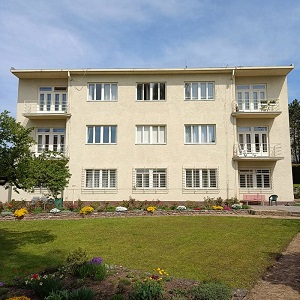
The reminder of architect Eisler also offered a tour of the house on Lipová Street in Brno
 |
Eisler was born on June 1, 1893, in Bystřice nad Pernštejnem. He obtained his architectural education in Brno, which he further developed, for example, in Vienna. After returning to Brno, he opened his own office and began closely cooperating with his brothers Artur and Mořic, who owned a large construction company. His design work fully developed in the 1930s in connection with the construction activities of the family firm, which at that time had up to 1,000 employees and realized projects by other significant architects, such as the Tugendhat villa.
According to Eisler's functionalist designs, many apartment buildings were created that were characterized by purist elegance, an emphasis on quality materials, and interesting architectural details. Several of them stand in the Masaryk district, which became a sought-after location for wealthy industrialists, often of Jewish descent, after World War I. The apartment building at Lipová 33 was commissioned by Otto Seidel in 1936. Shortly thereafter, however, considering the deteriorating prospects for Jews, he emigrated abroad.
"He sold the house to my great-grandfather, who rented an apartment there. In the 1950s, however, came Action 77, when 77,000 officials became workers, and it affected him too. At the same time, the bank increased interest rates, and although he tried to repay the house for some time, in 1964 he donated it to the state. One apartment remained for my family; they could live there, but had no rights of control. Some residents were very insensitive and made significant alterations, such as expanding the balcony or bricking up the loggias," said guide Viktor Kadeřábek.
His family managed to regain the house after the revolution, and his grandmother, who is the architect, renovated it to reflect Eisler's work as much as possible. This was also aided by its declaration as a cultural monument in 1999. Today, there are six apartments in the building, all occupied.
Eisler was one of the few interwar architects from Brno whose work was already published in foreign publications at the time of its creation, thus entering the awareness of experts beyond the borders of Czechoslovakia. During World War II, he was deported by the Nazis to the concentration camp in Auschwitz, where he met his brother Mořic. Together, they also experienced the death march to Buchenwald, where they were liberated by the American army. Ultimately, as the only ones among the Eisler brothers, they survived the war. In 1945, they returned to Brno and resumed their business activities. Otto was also involved in projects for the Brno zoo.
"Connecting his commemoration with the anniversary of the Jewish pogrom made sense to us, as he significantly influenced the face of modern Brno. He is also one of those figures who are not often remembered, which is a shame, and we want his name to return to the public space," Höferová stated. The highlight of the program is the laying of Stolpersteine for Otto and Mořic in front of their former residence, the famous House for Two Young Men.
The English translation is powered by AI tool. Switch to Czech to view the original text source.
0 comments
add comment











